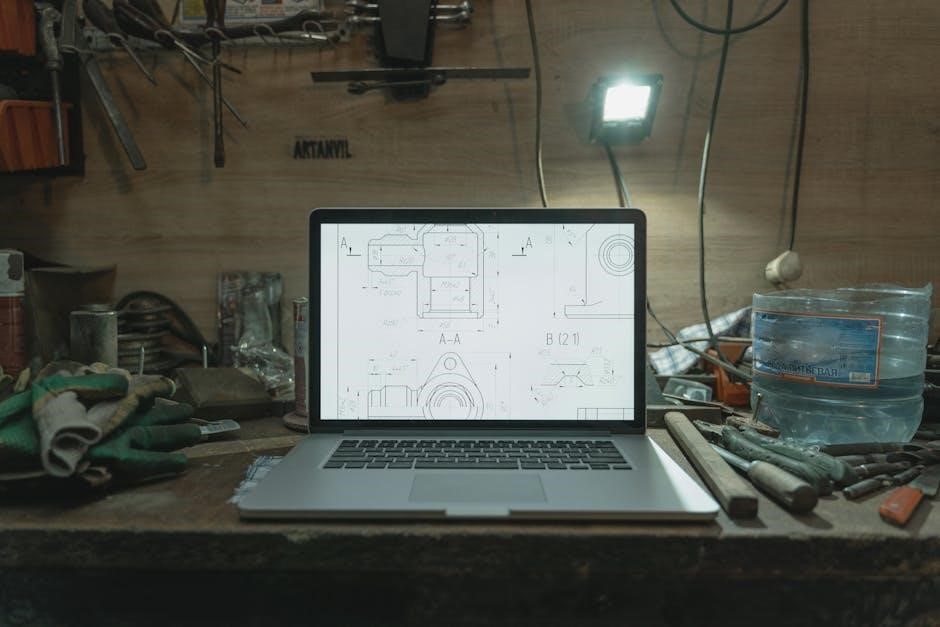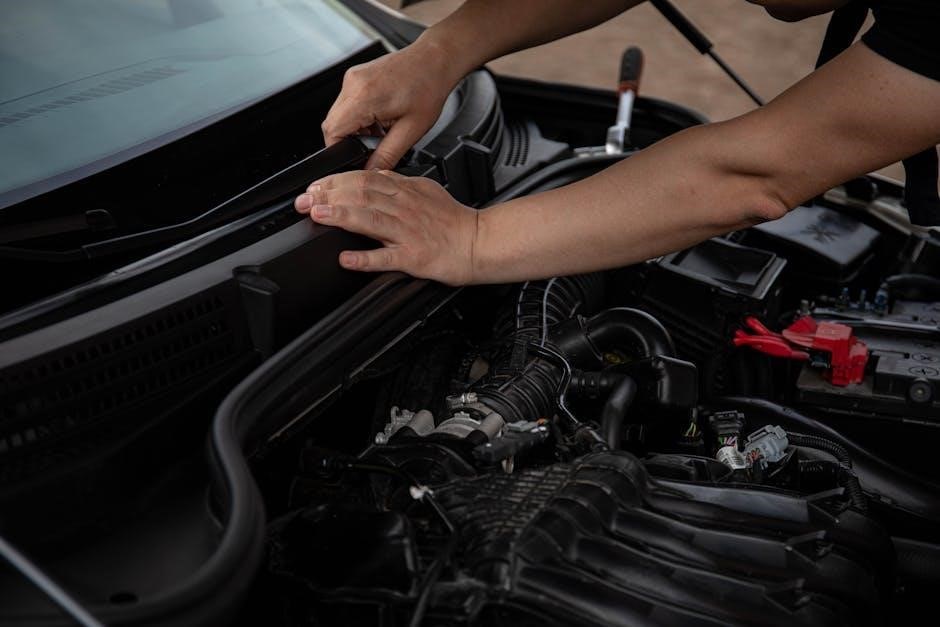clutch diagram for a manual transmission
The clutch is a crucial component in manual transmissions, acting as the intermediary between the engine and gearbox. It enables smooth gear shifts by temporarily disconnecting power efficiently.
Overview of the Clutch System
The clutch system is a vital mechanism in manual transmissions, enabling the temporary disconnection of engine power from the gearbox. It allows smooth gear shifts by interrupting power transmission. The system includes key components like the clutch pedal, flywheel, pressure plate, and clutch disc. When the pedal is pressed, the release bearing disengages the clutch, stopping power flow. Releasing the pedal re-engages the clutch, restoring power. Hydraulic or cable-operated systems control this process. A clutch diagram illustrates these parts and their interactions, showing how pressing the pedal activates the release bearing, which moves the diaphragm spring to disengage the clutch. Proper clutch operation ensures seamless gear changes and prevents wear on transmission components.
The Role of the Clutch in Manual Transmission
The clutch plays a pivotal role in manual transmissions by enabling the driver to smoothly engage and disengage the engine’s power from the gearbox. Its primary function is to interrupt power transmission momentarily, allowing seamless gear shifts without causing damage to the transmission. When engaged, the clutch connects the engine to the gearbox, enabling power transfer. When disengaged, it isolates the engine, permitting the driver to shift gears effortlessly. This mechanism is essential for starting from a standstill, accelerating, and navigating varying driving conditions. The clutch ensures precise control over power delivery, making it a fundamental component for effective vehicle operation. Proper clutch function is critical for maintaining smooth and efficient driving performance.
Key Components of the Clutch System
The clutch system comprises essential parts like the clutch pedal, flywheel, pressure plate, clutch disc, release bearing, and master/slave cylinders. Together, they facilitate smooth engagement and disengagement, ensuring efficient power transmission.
The Clutch Pedal
The clutch pedal is a fundamental component in a manual transmission system, allowing the driver to control the engagement and disengagement of the clutch. Located on the far left of the footwell, it is typically connected to the clutch assembly through a hydraulic or cable-operated linkage. When the driver presses the pedal down, it activates the release bearing, which disengages the clutch disc from the flywheel, interrupting power transmission to the gearbox. This allows the driver to shift gears smoothly without grinding or damaging the transmission components. The pedal’s operation relies on proper adjustment to ensure optimal performance and driver comfort. Improper adjustment can lead to difficulty in shifting gears or premature wear on the clutch system.
The Flywheel
The flywheel is a heavy, circular component bolted directly to the engine’s crankshaft and plays a vital role in the clutch system. Its primary function is to store rotational energy from the engine, ensuring smooth power delivery. The flywheel’s surface is machined to provide a friction surface for the clutch disc. When the clutch is engaged, the flywheel spins in unison with the engine, transferring power to the transmission through the clutch disc. The flywheel’s mass helps maintain engine speed consistency, reducing vibrations and ensuring smooth acceleration. In hydraulic clutch systems, the flywheel also houses the slave cylinder, which interacts with the release bearing to disengage the clutch when the pedal is pressed. Proper flywheel condition is essential for effective clutch operation and overall vehicle performance.
The Pressure Plate
The pressure plate is a key component in the clutch system, bolted directly to the flywheel. Its primary role is to apply consistent pressure on the clutch disc, ensuring proper engagement with the flywheel. This pressure is typically generated by a diaphragm spring or coil springs, depending on the clutch design. When the clutch pedal is released, the pressure plate clamps the clutch disc firmly against the flywheel, enabling power transfer from the engine to the transmission. The pressure plate’s surface is precision-machined to ensure even contact and consistent friction. Over time, wear on the pressure plate can reduce clutch performance, requiring inspection and potential replacement to maintain optimal functionality. Proper alignment and tension are critical for smooth operation and longevity of the clutch system.
The Clutch Disc
The clutch disc, also known as the friction plate, is a central component of the clutch system. It is mounted on the input shaft and features friction material on both sides, which engages with the flywheel and pressure plate. When the clutch is engaged, the disc is pressed firmly between these two components, enabling power transfer from the engine to the transmission. The friction material ensures smooth engagement and disengagement, allowing the driver to shift gears seamlessly. Over time, the friction material can wear down, leading to reduced performance and potential slippage. Regular inspection and replacement of the clutch disc are essential to maintain optimal clutch functionality and prevent costly repairs. The disc’s splined design allows it to move smoothly along the input shaft during operation.
The Release Bearing
The release bearing, also known as the throw-out bearing, plays a vital role in the clutch system by facilitating smooth disengagement. Located near the clutch fork, it is designed to apply pressure to the diaphragm spring in the pressure plate when the clutch pedal is pressed. This action releases the clamping force, allowing the clutch disc to disengage from the flywheel. The release bearing ensures that the driver can shift gears without difficulty or grinding. Proper lubrication and alignment are essential for its longevity. If the release bearing wears out or becomes misaligned, it can cause noise or make shifting gears challenging. Regular inspection and maintenance are crucial to prevent such issues and maintain efficient clutch operation.
Master and Slave Cylinders
The master and slave cylinders are integral components of a hydraulic clutch system, responsible for transferring pressure from the clutch pedal to the clutch mechanism. The master cylinder, located under the dashboard, converts non-hydraulic pedal pressure into hydraulic pressure. This pressure is then transmitted through a fluid-filled line to the slave cylinder, which is typically mounted on the clutch housing. The slave cylinder converts this hydraulic pressure back into mechanical energy, engaging the release fork to disengage the clutch. Proper synchronization and fluid levels are essential for smooth operation. Any leaks or air in the system can lead to clutch failure or spongy pedal feel, emphasizing the importance of regular maintenance and bleeding of the hydraulic system.

How the Clutch Works
The clutch operates by engaging and disengaging power between the engine and manual transmission. Pressing the pedal disengages the clutch, allowing gear shifts, while releasing it re-engages power smoothly.
Engaging the Clutch
Engaging the clutch involves releasing the pedal, allowing the diaphragm spring to clamp the clutch disc against the flywheel. This connection enables power to flow from the engine to the manual transmission, permitting smooth vehicle movement. The process ensures seamless energy transfer, essential for accelerating and maintaining speed. Proper engagement is critical to avoid wear on clutch components and ensure efficient gear transitions. When the pedal is fully released, the pressure plate applies consistent force, securing the clutch disc and resuming power transmission. This mechanism is fundamental to the operation of a manual transmission, enabling drivers to control speed and torque effectively.
Disengaging the Clutch
Disengaging the clutch occurs when the driver presses the pedal, activating the release bearing to reduce pressure on the clutch disc. This action separates the engine from the manual transmission, halting power transfer and allowing gear shifts without resistance. The diaphragm spring releases its grip, enabling the clutch disc to spin freely between the pressure plate and flywheel. Proper disengagement is essential for smooth gear changes and prevents damage to transmission components. Hydraulic or cable systems facilitate this process, ensuring precise control over the clutch mechanism. When the pedal is fully pressed, the vehicle can transition gears seamlessly, making it a critical function in manual transmission operation.
The Role of the Diaphragm Spring
The diaphragm spring is a key component in the clutch system, providing the necessary force to engage and disengage the clutch disc. When the clutch pedal is released, the spring applies pressure, clamping the clutch disc between the flywheel and pressure plate, ensuring smooth power transfer to the transmission. When the pedal is pressed, the spring releases, allowing the release bearing to disengage the clutch. This spring is crucial for consistent and precise clutch operation, enabling smooth gear shifts and preventing wear on other components. Its design ensures optimal performance in both engaging and disengaging modes, making it an essential part of the manual transmission system.

Types of Clutches
Single plate and multi-plate clutches are common, with the latter offering better heat dissipation. Materials like ceramic and organic discs vary in durability and friction properties, suiting different driving needs.
Single Plate Clutch
A single plate clutch is the most common type, featuring a single friction plate sandwiched between the pressure plate and flywheel. Its simple design makes it lightweight and cost-effective. The clutch plate has friction material on both sides, ensuring smooth engagement and disengagement. When the driver presses the clutch pedal, the release bearing moves, disengaging the clutch and interrupting power flow. Releasing the pedal allows the diaphragm spring to clamp the plate, reconnecting the engine to the transmission. This system is ideal for light-duty vehicles due to its ease of operation and maintenance. However, it generates more heat compared to multi-plate clutches, potentially reducing longevity in high-performance scenarios.
Multi-Plate Clutch
A multi-plate clutch enhances performance by utilizing multiple friction plates within a compact design. This setup increases the surface area for heat dissipation and friction, improving torque capacity. Ideal for high-performance or racing applications, multi-plate clutches reduce wear and tear under intense conditions. They operate similarly to single-plate clutches but offer superior grip and durability. The added plates allow for smoother power delivery and quicker engagement, making them popular in vehicles requiring rapid gear shifts. Despite their advantages, multi-plate clutches are heavier and more complex, often used in specialized or high-end vehicles where performance is critical. Their design ensures optimal functionality in demanding driving scenarios, making them a preferred choice for enthusiasts and professionals alike.
Ceramic vs. Organic Clutch Discs
Ceramic and organic clutch discs are two common types, each offering distinct advantages. Ceramic discs are made from synthetic materials, providing higher durability and heat resistance, making them ideal for high-performance driving. They offer a firmer bite and better friction, suitable for racing or heavy-duty applications. In contrast, organic discs are made from natural materials and are softer, resulting in quieter operation and smoother engagement. They are better suited for everyday driving due to their ability to absorb minor imperfections and provide a more comfortable feel. While ceramic discs last longer, they can cause more wear on other components. Organic discs, though less durable, are preferred for their smooth, jerk-free performance in regular driving conditions.

Troubleshooting Common Clutch Issues
Common clutch issues include wear, master/slave cylinder problems, and cable-operated clutch malfunctions. Symptoms like slipping, spongy pedals, or difficulty shifting gears often indicate underlying component failures requiring inspection and repair.
Clutch Wear and Tear
Clutch wear occurs over time due to friction between the clutch disc and the flywheel. Symptoms include a spongy pedal feel, difficulty shifting gears, and a burning smell. The clutch disc’s friction material degrades, reducing its ability to engage smoothly. If neglected, the disc can wear down completely, requiring costly replacement. Regular inspection of the clutch components, such as the disc and pressure plate, can help identify wear early. Proper driving techniques, like avoiding riding the clutch, can extend its lifespan. Addressing wear promptly prevents further damage to the transmission and ensures smooth gear engagement.
Master and Slave Cylinder Problems
Master and slave cylinders are critical components in hydraulic clutch systems. Issues arise when fluid leaks from the master cylinder, causing a spongy clutch pedal. The slave cylinder may also fail to engage the clutch properly, leading to difficulty shifting gears. Air in the hydraulic system can cause similar symptoms, requiring bleeding to resolve. Over time, wear in these cylinders can reduce clutch performance and lead to incomplete disengagement. Regular inspection of the hydraulic system and maintaining proper fluid levels are essential to prevent these issues. Addressing cylinder problems early ensures smooth clutch operation and avoids costly repairs down the line.
Cable-Operated Clutch Issues
Cable-operated clutch systems can experience issues such as stiff pedal action or difficulty engaging gears. This often stems from a damaged or stretched clutch cable, which may slip or fray over time. When the cable is compromised, it fails to transmit pedal movements accurately to the release arm, leading to poor clutch engagement. Additionally, lack of proper adjustment in the clutch linkage can cause the pedal to feel unresponsive or require excessive force. Regular inspection of the cable and linkage is essential to identify wear early. Replacing a damaged cable or adjusting the linkage can restore smooth operation. Ignoring these issues can result in clutch failure, making gear shifts challenging and potentially causing further damage to the transmission.
Maintenance and Repair
Regular maintenance, such as adjusting the clutch pedal and replacing worn components, ensures smooth operation. Bleeding the hydraulic system and inspecting the clutch disc prevent major repairs.
Adjusting the Clutch Pedal
Adjusting the clutch pedal ensures proper engagement and disengagement. Begin by locating the adjustment mechanism, typically a nut or screw on the pedal or master cylinder. Turn the nut to increase or decrease the pedal’s free play. Proper adjustment ensures the pedal operates smoothly, with a slight resistance when pressed. Over adjustment can lead to premature wear, while insufficient adjustment may cause slippage. Use a clutch diagram to identify components involved. After adjustment, test the pedal to ensure it engages and disengages fully. Regular checks prevent issues like difficulty shifting gears or clutch drag.
Replacing the Clutch Disc
Replacing the clutch disc is essential when it shows signs of wear, such as slippage or noise. Begin by removing the transmission to access the clutch assembly. Use a clutch diagram to identify components. Remove the pressure plate and carefully pull out the disc. Inspect the flywheel for damage and clean it thoroughly. Install the new disc, ensuring it aligns properly with the splines on the input shaft. Reattach the pressure plate and tighten the bolts evenly. Reinstall the transmission and bleed the hydraulic system if necessary. Proper alignment and torque are crucial to prevent imbalance and ensure smooth operation. Always refer to a detailed clutch diagram for guidance during the process.
Bleeding the Hydraulic System
Bleeding the hydraulic clutch system is crucial to remove air bubbles that can cause a spongy pedal or poor engagement. Start by locating the clutch master and slave cylinders, referencing a clutch diagram. Use a bleed kit to purge the system. Begin at the slave cylinder, pumping the pedal to circulate fluid. Continue until the fluid flows freely without bubbles. Repeat the process if necessary to ensure all air is removed. Proper bleeding ensures consistent clutch performance and prevents premature wear. Always use the recommended hydraulic fluid and work in a well-lit area for visibility. If issues persist, consult a professional mechanic to avoid further complications.

Manual vs. Automatic Transmission
Manual transmissions require driver engagement with a clutch pedal and gear shifter, offering control and efficiency. Automatics shift gears automatically, providing convenience but less driver involvement and typically lower fuel efficiency.
Advantages of Manual Transmission
Manual transmissions offer several advantages, including better fuel efficiency, lower maintenance costs, and increased driver control. They provide a more engaging driving experience, allowing drivers to manually select gears for optimal performance. Additionally, the ability to disconnect the engine from the wheels via the clutch enhances control in challenging driving conditions, such as uphill climbs or towing. The mechanical simplicity of manual transmissions also reduces the risk of complex failures compared to automatics. Furthermore, the need to use the clutch pedal and gearshift promotes active driver participation, making it a preferred choice for driving enthusiasts. Overall, manual transmissions are cost-effective and provide a more connected driving experience.
Disadvantages of Manual Transmission
Manual transmissions have certain drawbacks, including the need for constant driver engagement and the learning curve associated with mastering the clutch and gearshift. In heavy traffic, frequent shifting can be tiring and may lead to driver fatigue. Additionally, the clutch pedal can wear out over time, requiring costly replacements. Manual transmissions also limit the ease of driving in hilly or stop-and-go conditions, as constant use of the clutch and brakes is necessary. Furthermore, modern automatic and dual-clutch transmissions often match or exceed the fuel efficiency of manuals in urban driving scenarios. These factors make manual transmissions less convenient for some drivers, especially in environments where smooth, low-effort driving is preferred.
Modern Advancements in Clutch Technology
Modern clutch technology includes dual-clutch systems, clutch-by-wire, and intelligent manual transmissions, enhancing efficiency, driver control, and integration with hybrid systems for improved performance and reduced driver fatigue.
Dual-Clutch Transmission (DCT)
A dual-clutch transmission (DCT) uses two clutches to pre-select gears, offering seamless and faster shifting. One clutch controls odd gears, the other even, enabling smooth transitions without power interruption. This system combines the efficiency of manual transmissions with the convenience of automatics, reducing fuel consumption and enhancing performance. DCTs are commonly found in high-performance vehicles, providing quick acceleration and precise control. The clutch diagram illustrates how both clutches work in tandem, ensuring optimal gear engagement and disengagement. This advanced technology bridges the gap between manual and automatic transmissions, delivering a balance of driver involvement and modern convenience.
Clutch-by-Wire Technology
Clutch-by-wire technology eliminates traditional mechanical linkage, using electronic sensors and actuators to control clutch engagement. This system enhances precision and responsiveness, reducing driver effort. Sensors on the clutch pedal send signals to an electronic control unit, which activates an electric slave cylinder to engage or disengage the clutch. This setup allows for smoother and more consistent gear shifts. For example, Kia’s intelligent Manual Transmission (iMT) employs clutch-by-wire, enabling features like automatic rev-matching and seamless low-speed maneuvers. It also integrates with hybrid systems, improving fuel efficiency. This innovation combines the feel of a manual transmission with modern electronic refinement, offering a balance of control and convenience for drivers.

Understanding Clutch Diagrams
A clutch diagram provides a visual representation of the clutch system, highlighting components like the clutch pedal, flywheel, and pressure plate. It aids in understanding and repairing the system.
Reading a Clutch Diagram
A clutch diagram provides a detailed visual representation of the clutch system, showcasing its components and their interactions. It typically includes the clutch pedal, flywheel, pressure plate, clutch disc, and release bearing. The diagram illustrates how pressing the clutch pedal disengages the clutch by moving the release bearing, which stops power transmission to the gearbox. This allows smooth gear shifts. The diagram also shows how releasing the pedal re-engages the clutch, enabling power to flow again. By studying the diagram, one can understand how each part functions and connects, making it easier to identify issues or perform repairs. It is an essential tool for educators and mechanics, simplifying complex concepts for learners and professionals alike.
Importance of Clutch Diagrams in Education and Repair
Clutch diagrams are invaluable in both educational settings and repair scenarios. They provide a clear, visual understanding of the clutch system’s components and their relationships. For students and novices, diagrams simplify complex mechanical concepts, making learning more intuitive. In repair situations, technicians use these diagrams to diagnose issues efficiently, identifying faulty parts and understanding how they interact. The visual representation helps in planning repairs and ensuring all components are correctly reassembled. Overall, clutch diagrams enhance comprehension, reduce errors, and save time, making them an essential resource for anyone working with manual transmissions;
The clutch system is vital for smooth gear transitions in manual transmissions. Understanding its components and functionality ensures optimal performance and longevity, making it essential for drivers and technicians alike.
The Importance of Proper Clutch Maintenance
Proper clutch maintenance is essential for ensuring the longevity and performance of a manual transmission system. Regular inspection and timely replacement of worn components prevent sudden failures and costly repairs. Key maintenance tasks include adjusting the clutch pedal, inspecting the clutch disc for wear, and ensuring the hydraulic or cable system operates smoothly. Neglecting maintenance can lead to uneven engagement, slippage, or complete failure, which disrupts power transmission and compromises vehicle control. By addressing issues early, drivers can maintain optimal performance, reduce repair expenses, and ensure safer operation. A well-maintained clutch system enhances driving efficiency and extends the lifespan of the transmission, making it a critical part of vehicle care.
Encouraging DIY Clutch Maintenance
DIY clutch maintenance empowers car owners to take control of their vehicle’s health, fostering a deeper understanding of its mechanics. With a clear clutch diagram as a guide, enthusiasts can perform routine checks and adjustments, reducing reliance on professional services. Simple tasks like inspecting the clutch disc, cleaning components, and ensuring proper hydraulic fluid levels can prevent major issues. Online resources and tutorials provide step-by-step instructions, making the process accessible. DIY maintenance not only saves money but also builds confidence and mechanical skills. Encouraging this practice helps drivers identify potential problems early, ensuring their manual transmission system operates smoothly and efficiently for years to come.
